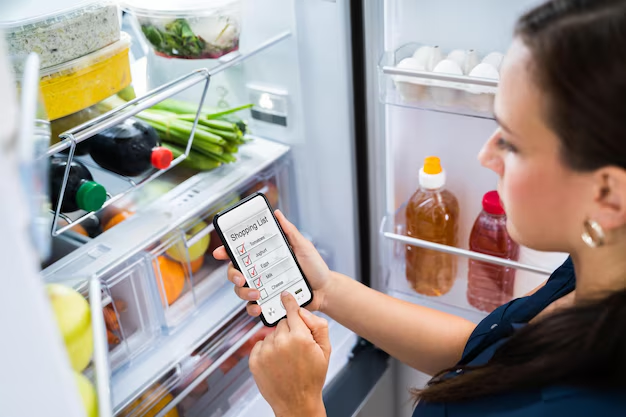Discover the Perfect Refrigerator Temperature for Optimal Food Safety and Preservation
Have you ever opened your refrigerator only to find that your vegetables are limp, or your milk has soured far earlier than expected? Ensuring your fridge is set to the correct temperature is key to extending your food's freshness and preventing waste. In this guide, we're unraveling everything you need to know about setting the right fridge temperature, offering tips to maintain it, and discussing related topics that matter for your kitchen.
🌡️ The Ideal Refrigerator Temperature: What You Need to Know
The recommended temperature for a refrigerator is typically between 35°F and 38°F (1.7°C and 3.3°C). Keeping your fridge within this range can extend the shelf life of perishable items and maintain their nutritional value.
Why the Right Temperature Matters
- Food Safety: A fridge temperature above 40°F can put your food in the danger zone where harmful bacteria thrive.
- Quality Preservation: Foods stored at the ideal temperature retain their flavor, texture, and nutrients longer.
- Energy Efficiency: A consistent fridge temperature ensures optimal operation, potentially reducing energy consumption.
🌿 Adjusting Your Fridge Settings for Best Results
Now that you know the ideal range, how do you go about setting your refrigerator accordingly?
Finding and Adjusting Controls
Most refrigerators allow temperature adjustments via a digital or dial control inside the fridge. Here's a quick guide on how to adjust those settings:
- Locate the Controls: Usually found in the fridge compartment or near the front, either as a dial or a digital control panel.
- Set the Temperature: If using a dial, typically marked from 0-9, consider setting it on 4 or 5. Digital controls can be directly set to a specific temperature.
- Check Regularly: Wait 24 hours after adjustment and use a separate fridge thermometer to verify the temperature.
Tips for Consistent Temperature
- Avoid Overcrowding: Proper air circulation is crucial for maintaining a steady temperature.
- Place Thermometers Efficiently: Keep a thermometer on a middle shelf for accurate readings.
- Close the Door Quickly: Minimize the time the door is open to avoid temperature fluctuations.
📦 Organizing Your Fridge for Better Temperature Distribution
Proper organization can significantly impact temperature distribution within your refrigerator. Here are simple steps you can follow:
Refrigerator Zones
- Top Shelf: Best for drinks and ready-to-eat foods.
- Middle Shelves: Ideal for dairy products and leftovers.
- Bottom Shelf: Raw meats should be stored here to prevent contamination from drips.
- Crisper Drawer: Perfect for preserving fruits and vegetables.
Practical Arrangement Tips
- Use Clear Storage Bins: Helps to organize smaller items, making them easily accessible.
- Label Leftovers: Clearly mark the date to prioritize consumption before spoilage.
- Avoid Blocking Air Vents: Ensure nothing obstructs the vents for optimal airflow.
❄️ Troubleshooting Temperature Issues
Even with things set perfectly, you might occasionally face issues with temperature regulation. Here are common problems and solutions:
Common Problems
- Inconsistent Temperature: Fluctuations could be due to frequent door openings, blockages, or an overloaded fridge.
- Ice Build-Up: Often indicates a defrosting issue. Check seals and ensure vents aren't blocked.
- Warm Spots: If certain areas seem warmer, rearrange food to prevent blocking of vents.
Solutions
- Routine Checks: Regularly verify the temperature with a dedicated thermometer.
- Maintenance: Clean coils and ensure door seals are intact to enhance performance.
- Professional Service: If problems persist, consider consulting a professional technician.
🚀 Step Up Your Fridge Game with These Advanced Tips
For those ready to go beyond the basics, consider these advanced strategies to optimize your refrigerator's performance and lifespan.
Maintenance and Upkeep
- Defrost Regularly: Especially for older models, manual or automatic defrosting prevents excessive ice build-up.
- Coil Cleaning: Periodically clean the condenser coils to ensure efficient operation.
- Door Seal Check: A quick dollar bill test can highlight seal issues—slip a bill in the door; if it slides out easily, the seal may need replacement.
Tech-Savvy Solutions
- Smart Thermometers: Connect to your phone for alerts about temperature changes.
- Energy Star Models: Consider upgrading for better energy efficiency and temperature maintenance.
🌟 Quick Guide: Key Tips for Refrigerator Temperature
Here's a quick, visually distinct summary to keep these tips handy:
- 🌡️ Ideal Temperature: 35°F to 38°F (1.7°C to 3.3°C)
- 📏 Check Regularly: Use a fridge thermometer for accuracy.
- ❌ Avoid Overcrowding: Allow air circulation for consistent cooling.
- 🔧 Maintenance Matters: Regular coil cleaning and seal checks.
- 📱 Upgrade Wisely: Consider tech upgrades for better efficiency.
Bringing It All Together
Understanding and maintaining the correct refrigerator temperature is not just about preserving your food; it's about enhancing overall appliance efficiency and food safety. By setting and regularly checking your fridge’s temperature, organizing its contents strategically, and performing routine maintenance, you ensure your groceries last longer, taste better, and are safe to consume. As technology evolves, embracing smart gadgets can make this task more convenient and precise. Keeping your refrigerator well-maintained and correctly set is a small effort with rewarding outcomes—a fresher and safer kitchen environment.
